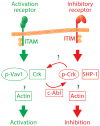The adaptor protein Crk in immune response
- PMID: 24165979
- PMCID: PMC4065865
- DOI: 10.1038/icb.2013.64
The adaptor protein Crk in immune response
Abstract
The adaptor proteins Crk (CT10 (chicken tumor virus number 10) regulator of kinase), including CrkI, CrkII and Crk-like, are important signal molecules that regulate a variety of cellular processes. Considerable progress has been made in understanding the roles of the Crk family proteins in signal transduction, with a focus on cellular transformation and differentiation. However, since Crk was identified in 1988, very few studies have addressed how Crk regulates the immune response. Recent work demonstrates that Crk proteins function as critical signal molecules in regulating immune cell functions. Emerging data on the roles of Crk in activation and inhibitory immunoreceptor signaling suggest that Crk proteins are potential immunotherapeutic targets in cancer and infectious diseases. The aim of this review is to summarize recent key findings regarding the role of Crk in immune responses mediated by T, B and natural killer (NK) cells. In particular, the roles of Crk in NK cell functions are discussed.
Figures




Similar articles
-
Inhibitory receptor signaling via tyrosine phosphorylation of the adaptor Crk.Immunity. 2008 Oct 17;29(4):578-88. doi: 10.1016/j.immuni.2008.07.014. Epub 2008 Oct 2. Immunity. 2008. PMID: 18835194 Free PMC article.
-
Crk adaptor proteins act as key signaling integrators for breast tumorigenesis.Breast Cancer Res. 2012 May 8;14(3):R74. doi: 10.1186/bcr3183. Breast Cancer Res. 2012. PMID: 22569336 Free PMC article.
-
The p130Cas-Crk/CrkL Axis: A Therapeutic Target for Invasive Cancers Unveiled by Collaboration Among p130Cas, Crk, and CrkL.Int J Mol Sci. 2025 Apr 24;26(9):4017. doi: 10.3390/ijms26094017. Int J Mol Sci. 2025. PMID: 40362257 Free PMC article. Review.
-
Immunophilins control T lymphocyte adhesion and migration by regulating CrkII binding to C3G.J Immunol. 2014 Oct 15;193(8):3966-77. doi: 10.4049/jimmunol.1303485. Epub 2014 Sep 15. J Immunol. 2014. PMID: 25225668
-
Myocardial ischemia/reperfusion injury: the role of adaptor proteins Crk.Perfusion. 2017 Jul;32(5):345-349. doi: 10.1177/0267659117691813. Epub 2017 Feb 1. Perfusion. 2017. PMID: 28553779 Review.
Cited by
-
microRNA-132 inhibits the proliferation, migration, and invasion of ovarian cancer cells by regulating CT10 oncogenic gene homolog II-related signaling pathways.Transl Cancer Res. 2020 Jul;9(7):4433-4443. doi: 10.21037/tcr-20-2435. Transl Cancer Res. 2020. PMID: 35117808 Free PMC article.
-
Crk Adaptor Proteins Regulate NK Cell Expansion and Differentiation during Mouse Cytomegalovirus Infection.J Immunol. 2018 May 15;200(10):3420-3428. doi: 10.4049/jimmunol.1701639. Epub 2018 Apr 4. J Immunol. 2018. PMID: 29618525 Free PMC article.
-
Phosphorylation of CrkL S114 induced by common gamma chain cytokines and T-cell receptor signal transduction.Sci Rep. 2021 Aug 20;11(1):16951. doi: 10.1038/s41598-021-96428-y. Sci Rep. 2021. PMID: 34417497 Free PMC article.
-
The tyrosine phosphatase SHP-1 promotes T cell adhesion by activating the adaptor protein CrkII in the immunological synapse.Sci Signal. 2017 Aug 8;10(491):eaal2880. doi: 10.1126/scisignal.aal2880. Sci Signal. 2017. PMID: 28790195 Free PMC article.
-
POU2F1 induces the immune escape in lung cancer by up-regulating PD-L1.Am J Transl Res. 2021 Feb 15;13(2):672-683. eCollection 2021. Am J Transl Res. 2021. PMID: 33594317 Free PMC article.
References
-
- Mayer BJ, Hamaguchi M, Hanafusa H. A novel viral oncogene with structural similarity to phospholipase C. Nature. 1988;332(6161):272–5. - PubMed
-
- Tsuchie H, Chang CH, Yoshida M, Vogt PK. A newly isolated avian sarcoma virus, ASV-1, carries the crk oncogene. Oncogene. 1989;4(11):1281–4. - PubMed
-
- Mayer BJ, Hamaguchi M, Hanafusa H. Characterization of p47gag-crk, a novel oncogene product with sequence similarity to a putative modulatory domain of protein-tyrosine kinases and phospholipase C. Cold Spring Harb Symp Quant Biol. 1988;53(Pt 2):907–14. - PubMed
-
- Reichman CT, Mayer BJ, Keshav S, Hanafusa H. The product of the cellular crk gene consists primarily of SH2 and SH3 regions. Cell Growth Differ. 1992;3(7):451–60. - PubMed
Publication types
MeSH terms
Substances
Grants and funding
LinkOut - more resources
Full Text Sources
Other Literature Sources

